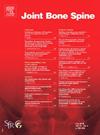那不勒斯预后评分与类风湿关节炎患者全因和心血管死亡风险的相关性:NHANES 2001-2018的横断面分析
IF 3.8
3区 医学
Q1 RHEUMATOLOGY
引用次数: 0
摘要
目的:本研究旨在评估那不勒斯预后评分(NPS)与RA患者死亡率的相关性。方法:本研究评估了2001年至2018年国家健康与营养检查调查(NHANES)数据库。利用血清白蛋白(SA)、总胆固醇(TC)、中性粒细胞与淋巴细胞比值(NLR)和淋巴细胞与单核细胞比值(LMR)计算NPS。采用自我管理的问卷收集RA患者的数据,并采用国家死亡指数确定死亡率。采用加权多变量Cox回归评价和Kaplan-Meier生存曲线评价,探讨NPS与RA死亡风险的相关性,并进行亚组分析和敏感性分析,考察相关性的稳健性。结果:共有1683名RA患者参加了这项研究。在Kaplan-Meier分析中,观察到不同组间全因和心血管(CV)死亡事件的生存率存在显著差异(结论:在美国人群中,NPS与RA患者的全因和CV死亡率的可能性呈显著正相关。将NPS整合到临床决策中可以为RA患者的预后提供更可靠的评估。本文章由计算机程序翻译,如有差异,请以英文原文为准。
Correlation of Naples prognostic score with the risk of all-cause and cardiovascular mortality in individuals with rheumatoid arthritis: A cross-sectional analysis of the NHANES 2001–2018
Objectives
This study seeks to assess how the Naples Prognostic Score (NPS) correlates with mortality in individuals with RA.
Methods
This study assessed the National Health and Nutrition Examination Survey (NHANES) database spanning from 2001 to 2018. NPS was computed utilizing serum albumin (SA), total cholesterol (TC), neutrophil to lymphocyte ratio (NLR), and lymphocyte to monocyte ratio (LMR). A self-administered questionnaire was utilized to gather data from individuals with RA, and the national death index was adopted to determine death rates. Weighted multivariate Cox regression evaluation and Kaplan–Meier survival curve assessment were carried out to explore the correlation of NPS with RA mortality risk, and subgroup analysis and sensitivity analysis were performed to investigate the robustness of the correlation.
Results
Altogether 1683 individuals with RA were enrolled in this research. In the Kaplan–Meier analysis, notable survival discrepancies were observed among various groups in all-cause and cardiovascular (CV) mortality events (P < 0.001). Following adjustment for all confounders, Group 3 (NPS = 3–4) exhibited a markedly heightened likelihood of all-cause mortality by 2.04 times (hazard ratio [HR] = 2.04, 95% confidence interval [CI]: 1.21–3.05, P < 0.01) and CV mortality by 3.59 times (HR = 3.59, 95%CI: 1.24–10.4, P < 0.05) in comparison to Group 1 (NPS = 0). Subgroup analysis and sensitivity analysis indicated that the results were robust.
Conclusion
In the US population, NPS shows a significantly positive correlation with the likelihood of all-cause and CV mortality in individuals with RA. The integration of the NPS into clinical decision-making can offer a more dependable evaluation of the prognosis of individuals with RA.
求助全文
通过发布文献求助,成功后即可免费获取论文全文。
去求助
来源期刊

Joint Bone Spine
医学-风湿病学
CiteScore
4.50
自引率
11.90%
发文量
184
审稿时长
25 days
期刊介绍:
Bimonthly e-only international journal, Joint Bone Spine publishes in English original research articles and all the latest advances that deal with disorders affecting the joints, bones, and spine and, more generally, the entire field of rheumatology.
All submitted manuscripts to the journal are subjected to rigorous peer review by international experts: under no circumstances does the journal guarantee publication before the editorial board makes its final decision. (Surgical techniques and work focusing specifically on orthopedic surgery are not within the scope of the journal.)Joint Bone Spine is indexed in the main international databases and is accessible worldwide through the ScienceDirect and ClinicalKey platforms.
 求助内容:
求助内容: 应助结果提醒方式:
应助结果提醒方式:


